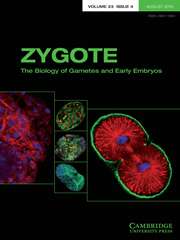No CrossRef data available.
Article contents
Are the number of nucleolar precursor body and size of pronuclear correlated with embryo development and ploidy status in 1PN zygotes?: an analysis through the time-lapse monitoring and pre-implantation genetic testing
Published online by Cambridge University Press: 13 December 2024
Abstract
This study aimed to demonstrate the utilization value of 1PN embryos. The 1PN zygotes collected from December 2021 to September 2022 were included in this study. The embryo development, the pronuclear characteristics, and the genetic constitutions were investigated. The overall blastocyst formation and good-quality blastocyst rates in 1PN zygotes were 22.94 and 16.24%, significantly lower than those of 2PN zygotes (63.25 and 50.23%, respectively, P = 0.000). The pronuclear characteristics were found to be correlated with the developmental potential. When comparing 1PN zygotes that developed into blastocysts to those that arrested, the former exhibited a significantly larger area (749.49 ± 142.77 vs. 634.00 ± 119.05, P = 0.000), a longer diameter of pronuclear (29.81 ± 3.08 vs. 27.30 ± 3.00, P = 0.000), and a greater number of nucleolar precursor body (NPB) (11.56 ± 3.84 vs. 7.19 ± 2.73, P = 0.000). Among the tested embryos, the diploidy euploidy rate was significantly higher in blastocysts in comparison with the arrested embryos (66.67 vs. 11.76%, P = 0.000), which was also significantly higher in IVF-1PN blastocysts than in ICSI-1PN blastocysts (75.44 vs. 25.00%, P = 0.001). However, the pronuclear characteristics were not found to be linked to the chromosomal ploidy once they formed blastocysts.
In summary, while the developmental potential of 1PN zygotes is reduced, our study shows that, in addition to the reported pronuclear area and diameter, the number of NPB is also associated with their developmental potential. The 1PN blastocysts exhibit a high diploidy euploidy rate, are recommend to be clinically used post genetic testing, especially for patients who do not have other 2PN embryos available.
- Type
- Research Article
- Information
- Copyright
- © The Author(s), 2024. Published by Cambridge University Press
Footnotes
These authors contributed equally to the research and preparation of the manuscript.



